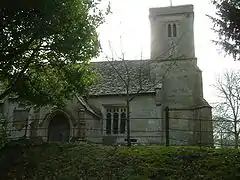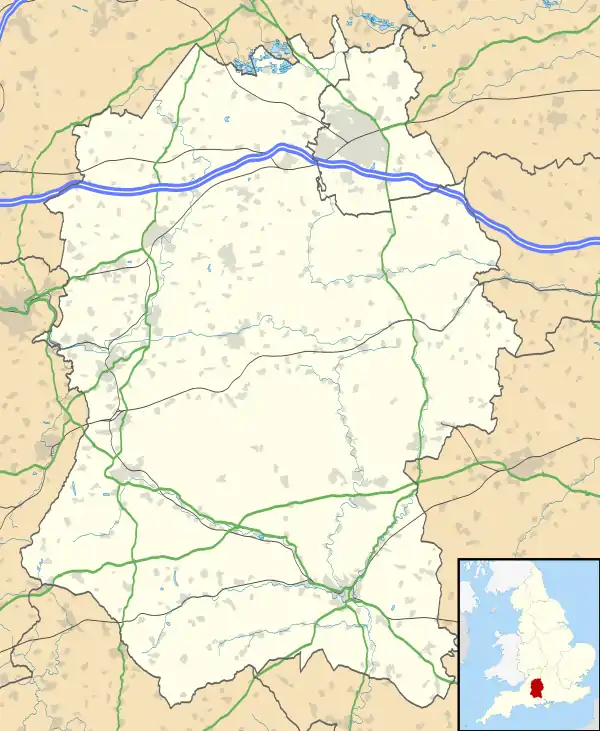Calstone Wellington
Calstone Wellington is a small village and former parish in Wiltshire, England, some three miles (5 km) from Calne and now part of the civil parish of Calne Without.
| Calstone Wellington | |
|---|---|
 Church of St. Mary, Calstone | |
 Calstone Wellington Location within Wiltshire | |
| OS grid reference | SU025684 |
| Civil parish | |
| Unitary authority | |
| Ceremonial county | |
| Region | |
| Country | England |
| Sovereign state | United Kingdom |
| Post town | CALNE |
| Postcode district | SN11 |
| Dialling code | 01249 |
| Police | Wiltshire |
| Fire | Dorset and Wiltshire |
| Ambulance | South Western |
| UK Parliament | |
The source of the River Marden is at Calstone Wellington, and most of the land is chalk downland.[1] The Calstone and Cherhill Downs is a biological SSSI, notified in 1971.[2]
Name
The name 'Calstone' may have developed from Calne east tun, meaning that the village was a rural extension of the neighbouring town of Calne. In about 1600, a small manor of Calstone was given the name of Calstone Wellington, in which 'Wellington' was the name of the lords of the manor in the 13th and 14th centuries.[3]
History
The Ridgeway, an ancient road dating from the Bronze Age, meets the early medieval Wansdyke near Calstone Wellington.[4]
Calstone was probably part of the large royal estate of Calne which was held by the kings of England in the 10th century, and perhaps also before that. By the time of the Norman conquest of 1066, most of this royal estate had been granted away from the Crown as a series of smaller estates, including Calstone, Calstone Wylye, the future Calstone Wellington, and the future Blunt's. The 'black land' of Calstone was held by the Crown until 1194, when it was granted to a new owner and became the manor and parish of Blackland.[3]
What later became the manor of Calstone Wellington was held in 1066 by Edric and in 1084 and 1086 by his widow Estrild. In 1086 it was assessed as 2½ hides and Estrild held it of Ernulf de Hesdin. It appears to have descended with the manor of Keevil the Hesdin and FitzAlan families and was held by Edmund of Woodstock, 1st Earl of Kent, when he died in 1330. In the 13th century Calstone Wellington was part of the lands held of the lord of the manor of Keevill by service of castle guard at Devizes, and still in 1349 it was held of the king or the grantee of Devizes Castle in the same way. In 1377, Calstone had 79 poll-tax payers.[3]
One boundary of Calstone Wellington was a Roman road, another a prehistoric ditch, while at its northern end the boundary crossed a prehistoric hill fort.[3]
By 1475, a fulling mill was operating in the village. It later became a corn mill. In 1640, the Manor House of Calstone Wellington, owned by a Royalist named Ducket, was burned down.[5]
In the early 18th century, the Rev. George Millard founded a charity school at Calstone Wellington, with places in it for six children, but due to the low population of the village vacant places sometimes had to be filled by poor children from Calne.[6] In 1843, a cottage in the parish was still used as a school.[7]
In the early 19th century, before enclosure, the arable fields of Calstone Wellington were scattered in the open fields of Calstone and Blackland. After enclosure, which took place in 1813,[8][9] most of Calstone Wellington was a compact area of some 260 acres (1.1 km2) around Manor Farm, but it also included other detached parts.[3]
In 1827, a meeting house was certified for the use of Wesleyan Methodists.[10]
On 25 March 1835, as a result of the Poor Law Amendment Act 1834, the Calne Poor Law Union was formed, consisting of the parishes of Calne, Blackland, Bowood, Bremhill, Calstone Wellington, Cherhill, Compton Bassett, Heddington, Highway, Hilmarton, and Yatesbury. These parishes had had a population at the 1831 census of 8,973, of which Calstone Wellington's was the smallest.[11]
In 1883, there was a tidying up of parish boundaries, in which 7 acres (2.8 ha) of the parish were transferred to Cherhill, ten to Blackland, and other detached parts to Calne, while at the same time about 20 acres (8.1 ha) lying to the north-west of Calstone Village was transferred to Calstone Wellington from Calne and Blackland. In 1885, Calstone Wellington amounted to 284 acres (1.15 km2), but in 1890 the whole of Calstone and Blackland, including Calstone Wellington, became part of the civil parish of Calne Without.[3]
The River Marden rises at the western end of a valley named Ranscombe Bottom, and in about 1882 a reservoir to supply water to Calne was created by damming the river in the village.[3]
In 1716, Calstone Wellington contained only four families.[6] In 1831, the population was 32,[12] and in 1841 it was 28. By 1999, the population had fallen.[3]
In 1908, ploughing with oxen came to an end on Manor Farm, Calstone Wellington.[13] In 1958, heavy horses were still at work on the farm.[14]
Church
By 1301 a church had been built at the village of Calstone, although what was to become Calstone Wellington remained part of the ecclesiastical parish of Calne.[3]
The present-day St Mary's parish church, which had that dedication by 1763, was rebuilt in the 15th century of stone rubble and ashlar and has a chancel, a nave, a north porch, a south vestry, and a west tower. The timber roofs of the nave and porch also date from the 15th century. A west gallery was built in the 18th century, and in 1884–1885 the church was restored by Ewan Christian, when the vestry was added, the chancel was re-roofed, narrow windows in the nave and chancel were replaced by larger windows in a 15th-century style, and the gallery was removed. The church had two bells in 1553, and another made by John Wallis in 1603 was the only bell in the tower until 1885, when two new bells cast by John Taylor & Co. of Loughborough were added. All were still in use in 2000.[3][15]
The parish registers now held in the Wiltshire and Swindon History Centre begin in 1760 and run up to 1963 for baptisms and burials, 1980 for marriages.[3][12]
In 1881, the Church of England's ecclesiastical parish of Calstone Wellington was united with the benefice of Blackland. In 1962, it was moved into a new union with Heddington, and then in 1973, together with the parishes of Cherhill, Yatesbury, and Compton Bassett, it became part of a new benefice called Oldbury.[15]
Representation
Following the Great Reform Act, the parliamentary borough of Calne lost one of its two members of parliament and its boundaries were changed to bring in parts of Calstone Wellington and Blackland. Calne was abolished as a constituency with effect from the 1885 election, after which Calstone Wellington was included in the Chippenham county division.
Notes
- Wiltshire Community History, Calne Without at wiltshire.gov.uk, accessed 10 May 2010
- Calstone and Cherhill Downs: Natural England citation sheet Archived 24 October 2012 at the Wayback Machine at sssi.naturalengland.org.uk
- 'Calstone Wellington', in A History of the County of Wiltshire, Volume 17: Calne (2002), pp. 123–135 at british-history.ac.uk, accessed 9 May 2010
- Arnold Fellows, England and Wales: a traveller's companion (2nd edition, 1964), p. 351 at books.google.co.uk
- Calne timeline Archived 27 September 2011 at the Wayback Machine at kennet.gov.uk, accessed 10 May 2010
- Donald A. Spaeth, The Church in an age of danger: parsons and parishioners, 1660–1740, p. 225 online
- Wiltshire and Swindon Archives, Ref. no. 727/3/1 Archived 3 October 2011 at the Wayback Machine at wiltshire.gov.uk
- John Britton, The Beauties of Wiltshire, Volume 3, p. 403 online
- CALNE, CALSTONE WELLINGTON AND BLACKLAND—An Act (22d of June 1813) for enclosing Lands in these Parishes
- Methodist Chapel, Calstone Wellington, Calne Without, at wiltshire.gov.uk, accessed 10 May 2010
- Calne, Wiltshire Archived 5 August 2010 at the Wayback Machine at workhouses.org.uk
- Calstone Wellington at genuki.org.uk, accessed 10 May 2010
- Ploughing by Oxen, Calstone Wellington at wiltshire.gov.uk, accessed 10 May 2010
- Manor Farm, Calstone Wellington at wiltshire.gov.uk, accessed 10 May 2010
- Calstone Wellington: St Mary the Virgin, Calstone Wellington at achurchnearyou.com, accessed 10 May 2010
External links
- Calstone Wellington map at aboutbritain.com
- Calstone Wellington map at travellers-world.info
- Church of St Mary, Calstone Wellington, Calne Without, photograph at wiltshire.gov.uk
